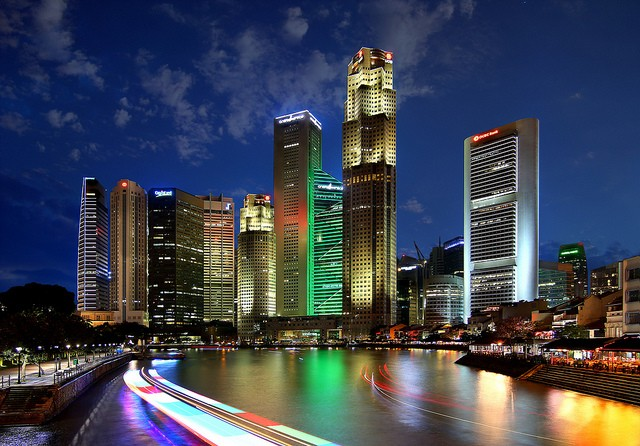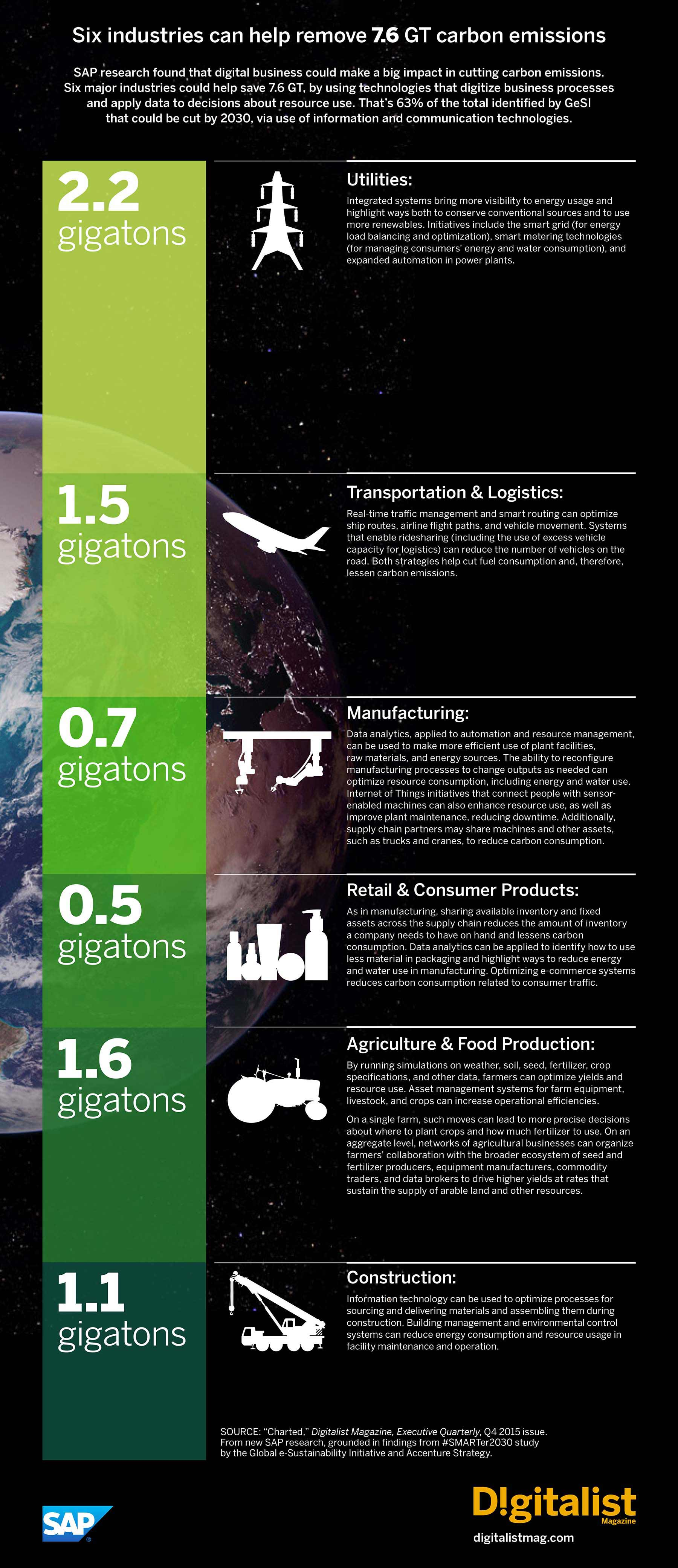
As governments around the world race to find new and innovative ways to slash carbon emissions in order to meet their climate targets, new research by technology provider SAP has found that massive cuts can be achieved through the digitisation of six industries.
Europe’s largest software company estimates that digitising business processes and applying data to monitor resource use can help save around US$33 trillion worth of resources, and cut greenhouse gas emissions by 7.6 gigatonnes by 2030.
This makes up 63 per cent of the total greenhouse gas emissions identified by the Global e-Sustainability Initiative (GeSI) – a global organisation advocating the use of technology to drive a sustainable future – that could be cut by 2030 through the use of infocomm technologies.
It also means a potential 13 per cent cut of the 57 to 59 gigatonnes of global greenhouse gas emissions the world will produce by 2030, according to estimates by the UK-headquartered Grantham Research Institute on Climate Change and the Environment.
The six industries identified by the Frankfurt-listed SAP are: utilities, agriculture and food production, transport and logistics, construction, manufacturing, and retail and consumer production.

In a recent interview, Steve Van Wyk, head of business analytics at SAP Asia Pacific Japan, notes that the world “is at an inflection point”.
It is a world in which the “the variety, velocity and veracity of data coming at us… creates a unique set of challenges for businesses and (this) makes decision-making extremely difficult”, he says.
“The idea of digitisation is essentially taking some of these business processes and automating them…. And decisions can be made by systems that are hyper-connected, and business processes – without human intervention – can be a lot faster,” he explains.
Technology and climate
One area that technology can have a big impact is agriculture.
By tapping into big data capabilities, agricultural conditions such as weather or soil composition can be interpreted to help farmers can make the best use of water, herbicides and pesticides to optimise crop yields.
This is especially important for emerging markets, where economic development and environmental conservation are often seen to be in conflict, says Van Wyk, who initially joined SAP Africa in 2010 before moving to Singapore last year to join SAP Asia.
“The idea of digitisation is essentially taking some of these business processes and automating them…. And decisions can be made by systems that are hyper-connected, and business processes – without human intervention – can be a lot faster."
Steve Van Wyk, head of business analytics, SAP Asia Pacific Japan
By integrating energy and water utility systems through digitisation, users can also better understand energy and water usage through smart metering. Ways to conserve conventional sources and use more renewables are also possible as digitisation further consolidates the systems, he adds.
In Singapore, for example, smart metering technologies and the digitisation of its power grid to optimise the efficiency of electricity consumption would be an important tool for the country in cutting carbon emissions.
The country has pledged under the Paris Agreement to reduce emissions intensity by 36 per cent from 2005 levels by 2030, and stabilise emissions with the aim of peaking around 2030.
Harnessing sensors and technology to capture data on weather patterns could help the country cope with the fickleness of solar power’s electricity generation – a source of energy that the Singapore government is investing in to help achieve its climate targets.
Further efficiencies can be gained through digitisation of other pillars of Singapore’s economy, such as construction, transport and logistics as well as manufacturing.
The age of IoT
Apart from using sensors to collect data on electricity systems, almost any other object such as industrial machines and web-enabled devices can be used to gather data about their surroundings, prompting experts to call this century the age of the IoT, or Internet of Things.
“Today, there are more web-enabled devices than there are people. By 2020, we would have 212 billion web-enabled devices talking to one another and generating data,” notes Van Wyk, who has over 20 years’ experience in the enterprise software business, and particularly, in the area of analytics.
These systems of interrelated objects - computing devices, mechanical and digital machines, objects, animals or people that are provided with unique identifiers – are able to transfer data over a network without human intervention.
This massive amount of data collected through IoT are would mean nothing if technology cannot interpret and act on it. This is where analytics is key.
In buildings, sensors use analytics to automatically adjust heating and lighting, while manufacturing equipment automatically alerts maintenance personnel to an impending failure.
Business operations can also improve efficiency. “Hyper-connected systems decide on the action based on triggers between machines – all these make the execution of a business process a lot faster because decisions are made around large amounts of data without human interaction,” he explains.
The rapid analysis of big data can now help business operations automatically make real-time decisions based on preset parameters.
This means that real-time data analytics software like SAP’s HANA (also known as High-Performance Analytic Appliance) allows business owners to use its software to improve the efficiency of existing ways of doing things while using less resources.
Taking analytics a step further is predictive analytics, a technique that forecasts based on existing data, enabling the projection of peaks and troughs of renewable energy output, like those from solar or wind power.
Users need not be a “data scientist” in writing a procedure or formula for solving a problem like algorithms, but “a citizen data scientist”, says Van Wyk, emphasising the importance of knowing what the analytics should look out for. And the more data is applied, “we get a much richer predictive algorithm to it”.
To Van Wyk, sustainability is actually a business outcome that can be achieved though the digital economy: “That is how SAP is going to the market with our customers today – how we are going to affect businesses and innovate with the digital economy and the digital approach to the digital economy itself.”
